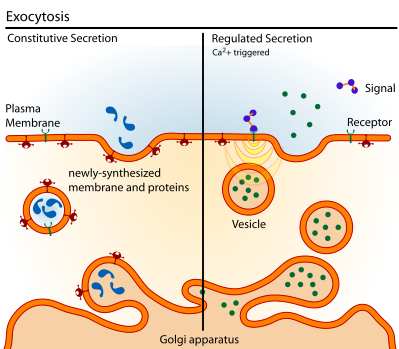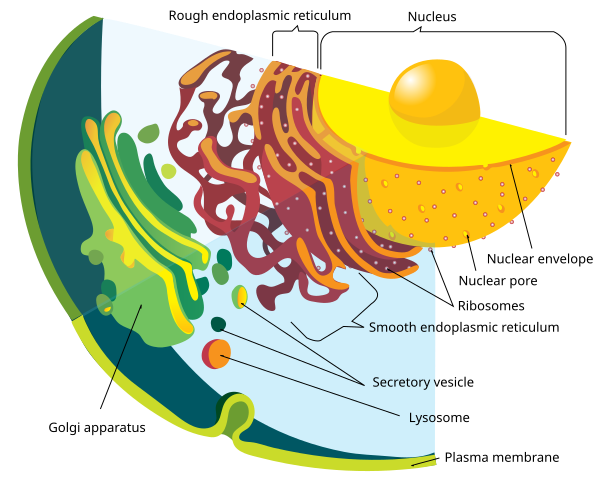OCR Specification focus:
‘Explain organelle interrelationships in protein production and secretion, and cytoskeleton roles in cells.’
Protein synthesis and secretion depend on coordinated interactions between multiple membrane-bound organelles and an intracellular cytoskeleton that supports cell shape and movement. These systems ensure polypeptides are made, processed, packaged, and transported to their correct destinations with high efficiency in eukaryotic cells.
Overview of organelles in protein synthesis
Eukaryotic protein synthesis begins at the ribosome, a large molecular complex responsible for polypeptide production.
Ribosome: A cellular structure made of rRNA and protein that assembles amino acids into polypeptides during translation.
Some ribosomes are free in the cytosol, while others are bound to the rough endoplasmic reticulum (rER), forming the first stage of the pathway for proteins destined for secretion, the plasma membrane, or lysosomes. Free ribosomes produce proteins for use inside the cell, whereas rER-bound ribosomes synthesise proteins that will be transported elsewhere.
Rough endoplasmic reticulum and protein modification
The rER is a network of membrane-bound flattened sacs studded with ribosomes. As a polypeptide is synthesised, it is fed into the rER lumen where it is folded into its three-dimensional shape. Within the rER, enzymes catalyse the formation of disulphide bridges and may add carbohydrate groups, forming a glycoprotein.
Golgi apparatus and protein packaging
Proteins leave the rER in transport vesicles that move along cytoskeletal tracks to the Golgi apparatus, a stack of flattened membrane sacs. The Golgi further modifies, sorts, and packages proteins. Its key roles include:
modifying carbohydrate groups to create complex glycoproteins
processing and activating lysosomal enzymes
packaging proteins into secretory vesicles or vesicles destined for organelles such as lysosomes
Exocytosis and secretion
Secretory vesicles carry proteins to the plasma membrane, where they fuse with it and release their contents by exocytosis, a process that requires ATP.

Diagram of exocytosis, showing vesicle docking, membrane fusion, and release of protein cargo to the extracellular space. The artwork distinguishes constitutive versus regulated exocytosis; this extra distinction exceeds the syllabus detail but helps students understand why some cells secrete continuously while others store then release on a signal. Source.
Interrelationship of organelles in protein production and secretion
The pathway can be summarised as:
Transcription in the nucleus produces mRNA
Translation at ribosomes produces polypeptides
rER folds and initially modifies proteins
Golgi apparatus completes modification and packages vesicles
Vesicles transport and fuse with membranes for secretion
The nucleus, rER, Golgi, ribosomes, and vesicles therefore form a continuous and interdependent system.

A schematic of the endomembrane system highlighting the coordinated roles of rER, Golgi apparatus, transport vesicles and the plasma membrane in secretion. Labels clearly mark organelles and vesicle flow. The diagram also shows lysosomes, which are not the focus of this page but are a natural endpoint for some Golgi vesicles. Source.
The cytoskeleton: structure and components
The cytoskeleton is a dynamic network of protein fibres that supports organelle movement, maintains cell shape, and drives cell division and motility. It is present in all eukaryotic cells. Key components include:
Microtubules
Microtubules are long, rigid, tubulin protein cylinders that determine cell shape and provide tracks for vesicle transport. They form the spindle during mitosis and underpin the structure of cilia and flagella.
Microfilaments
Microfilaments are thin, contractile, actin fibres that support the cell cortex and enable cytoplasmic streaming and cell movement. They also assist in cytokinesis and maintain mechanical strength.
Intermediate filaments
Intermediate filaments are rope-like fibres that stabilise organelle position and help cells resist tension. They provide strong structural support, particularly in tissues subject to mechanical stress.
Cytoskeleton roles in transport and secretion
The cytoskeleton links directly to protein secretion because motor proteins, such as kinesin and dynein, use ATP to move vesicles along microtubules between the rER, Golgi, and plasma membrane. In addition:
actin filaments aid vesicle docking at the membrane
microtubules determine the spatial distribution of organelles
cytoskeletal remodelling allows cells to change shape during secretion
This coordinated system ensures the correct timing and direction of vesicle movement.
Integration of protein synthesis and the cytoskeleton
The cytoskeleton not only moves vesicles but also holds the rER and Golgi in position, enabling efficient protein flow. Its structural and motor components interact continuously with organelles, creating an integrated cellular transport network. Without the cytoskeleton, protein transport would be slow, random, and ineffective, and secretion would fail.
Overall, protein synthesis and secretion rely on a sequence of precisely regulated organelle functions supported by an active cytoskeleton that organises, moves, and positions cellular components.
FAQ
rER-bound ribosomes produce proteins destined for secretion, insertion into membranes, or packaging into lysosomes. Their polypeptides enter the rER lumen during synthesis for folding and modification.
Free ribosomes remain in the cytosol and make proteins used inside the cell, such as metabolic enzymes. Although structurally identical, the fate of the protein depends on the ribosome’s location.
Motor proteins such as kinesin and dynein use energy from ATP hydrolysis to “walk” along microtubules.
Kinesin usually moves vesicles towards the cell surface
Dynein typically moves them towards the cell interior
The protein undergoes shape changes with each ATP molecule, allowing stepwise movement that keeps vesicle transport fast and directional.
Vesicles protect proteins from degradation and prevent unwanted reactions within the cytosol.
They also maintain organisation by ensuring proteins are delivered to precise locations, such as the Golgi or plasma membrane, rather than diffusing randomly. This compartmentalisation allows faster, more controlled secretion.
Proteins carry molecular “tags” such as specific carbohydrate groups or short amino acid sequences. These tags are recognised by receptors in the Golgi membrane.
Vesicles then bud off with the correct cargo and are directed along cytoskeletal tracks to a specific membrane or organelle, ensuring accuracy in secretion.
Microtubules can be rapidly assembled or disassembled, allowing the network to reorient so vesicles have a shorter or more direct route to the plasma membrane.
Actin filaments near the membrane also remodel to assist with vesicle docking and fusion. This flexibility makes secretion more efficient when demand increases, such as in hormone-releasing cells.
Practice Questions
Question 1 (2 marks)
State two roles of the cytoskeleton in eukaryotic cells.
Question 1 (2 marks)
Award 1 mark for each valid role, up to 2 marks:
Provides mechanical support / maintains cell shape (1)
Enables movement of vesicles or organelles within the cell (1)
Involved in movement of the cell / cell motility (1)
Forms spindle fibres for chromosome movement in mitosis/meiosis (1)
Question 2 (6 marks)
Describe how organelles work together in the production and secretion of proteins, from the formation of a polypeptide to its release from the cell. Include the roles of the rough endoplasmic reticulum, Golgi apparatus, and vesicles in your answer.
Question 2 (6 marks)
Award up to 6 marks for the following points:
Ribosomes on the rough ER synthesise polypeptides (1)
Polypeptides are folded and modified in the rough ER, e.g., forming glycoproteins (1)
Transport vesicles bud off from the rough ER and carry proteins to the Golgi apparatus (1)
The Golgi apparatus further modifies, sorts, and packages proteins (1)
Secretory vesicles move along cytoskeletal pathways to the plasma membrane (1)
Vesicles fuse with the plasma membrane and release proteins by exocytosis (1)
Accept equivalent wording.

